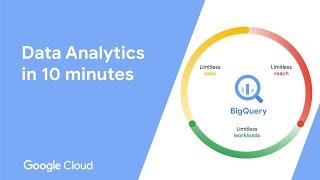
Google Cloud Data Analytics in 10 minutes
Комментарии:

A much needed summary of the data science tools of GCP 🥳🥳
Ответить
takeaways:
Interoperable and limitless data ecosystem
Serverless analytics using BigQuery
Scalable and secure data analysis across multiple clouds
Business intelligence capabilities
Real-time data ingestion and processing
Ability to handle structured, unstructured, and semi-structured data
Integrated data sharing functionality
Access to internal, public, commercial, and exclusive data sets
Breaking down the concepts:
Interoperable and limitless data ecosystem: This refers to the ability to work with data of any size, type, and format without experiencing limitations. It enables users to analyze, model, and present data from multiple sources, including internal, public, commercial, and exclusive data sets.
Serverless analytics using BigQuery: BigQuery is the core component of Google Data Analytics and is built with the aim of providing a serverless analytics solution. It enables users to analyze data of any size or type without incurring operational overhead and is built with security, reliability, elasticity, and flexibility in mind.
Scalable and secure data analysis across multiple clouds: Google Data Analytics allows users to analyze data across multiple clouds and is designed to be scalable, both horizontally and vertically, to meet the needs of organizations. It is also built with security in mind and allows users to access data from other teams and organizations without having to make copies.
Business intelligence capabilities: Google Data Analytics comes with free, real-time, and embedded business intelligence capabilities that allow users to quickly get an overview of their business. These capabilities can be used to model future trends and present data in a way that is easy for business users to understand and act on.
Real-time data ingestion and processing: Google Data Analytics supports real-time data ingestion, allowing users to process real-time data without having to set up additional products, tools, or infrastructure.
Ability to handle structured, unstructured, and semi-structured data: Google Data Analytics can handle structured, unstructured, and semi-structured data, providing a flexible solution for data analysis.
Integrated data sharing functionality: Google Data Analytics enables integrated data sharing, allowing users to access internal, public, commercial, and exclusive data sets in one place. It provides a frictionless experience for analyzing data across Google's open ecosystem.
Access to internal, public, commercial, and exclusive data sets: Google Data Analytics provides access to a wide range of data sets, including internal, public, commercial, and exclusive data sets such as Search Trends.
Interoperable and limitless data ecosystem: Consider a scenario where a fashion retailer needs to quickly and securely combine internal data and external data to analyze fleet management costs. With Google Data Analytics, the retailer can work with data of any size, type, and format, enabling them to innovate and solve problems faster.
Serverless analytics using BigQuery: Imagine a scenario where a data analyst needs to analyze data of any size or type. With BigQuery at the core of Google Data Analytics, the analyst can quickly and easily analyze data without incurring operational overhead and without having to worry about running out of capacity.
Scalable and secure data analysis across multiple clouds: Consider a scenario where a data analyst needs to access data from other teams and organizations. With Google Data Analytics, the analyst can access data from multiple clouds securely, without having to make copies, and the analytics platform scales to meet the needs of the organization.

interesting, too much knowledge shared within 10 minutes
Ответить
5 minutes in and still no idea how I use this.
Ответить
Probably the best video for data analytics. This illustrates beautifully how a business makes informed decisions with a solid example with various GCP products.
Ответить
🎉
Ответить

























